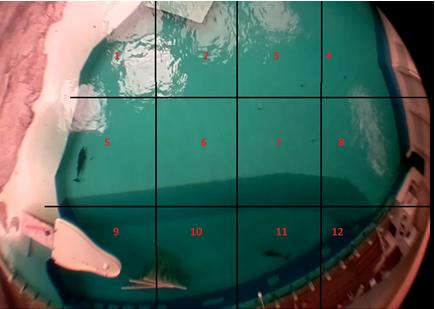Observations

Habituation process towards the devices
In order to understand if and how the dolphins would respond to a novel object in their water column, behavioural observations were done one day a week, during the first three weeks after the first introduction of the CPODs in the dolphin pool. Five behaviours (Swimming past no clear interaction, Quick look, Approach, investigation and Touch) were scored continuously for every first five minutes of every hour (from 6.00 to 18.00). A total of 65 minutes for each week was analysed.
Movement patterns
The top view camera recordings were used to analyse the movement patterns. For analysis the pool was divided into 12 virtual areas. As soon as the dolphins’ rostrum entered a new area, the number of this area was recorded. The Observer XT 12 software was used to record the areas that the dolphins swam in. Automatically the time of entrance in a certain area, and time of entrance in the next was recorded within this software. In Excel calculations were done concerning the total spend duration and times of visit of each area. A total of 520 minutes of video recordings were used, and a total of 146 dolphin movement patterns were recorded.
Landmark use and frequency
The AquaClickView software was used to find clicks trains directly aimed at the PCL. The inter-click interval (ICI) of these click trains was typically between 100ms and 2ms. Click-trains with decreasing, increasing and constant ICIs were classified and used for analysis. Constant ICIs below 10ms were recognized as a buzz. Underwater video footage or footage from above was used to analyse the behaviour of the dolphin that emitted the click train towards the PCL at that particular moment. The start and end time of the click train, its ICI, the distance and the behaviour of the dolphin were noted in an Excel datasheet.
Several periods during resting were defined. During these periods, the dolphin group was not interacting with trainers, staff, visitors or other enrichment devices such as rubber balls and were seen typically circling the pool clockwise at a slow pace, in groups of between two and six dolphins. During these events, the time that the dolphins were either within a range of 3 meters from the PCL, or pointing towards it whilst being present in the deepest area of the pool was recorded. Correspondingly with the times that the dolphins were present around the PCL, the AquaClickView software was used to record the number and type of click trains, and their ICI to get an idea of the frequency of landmark use during resting periods.
Responsible for this page:
Director of undergraduate studies Biology
Last updated:
05/13/15
